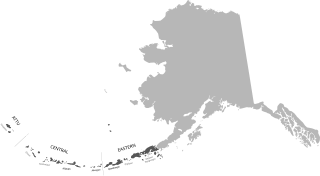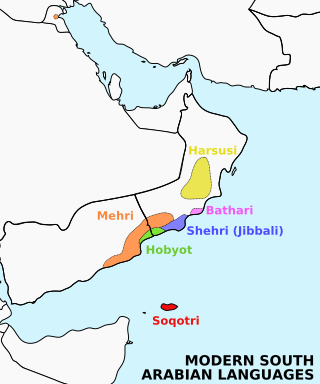Related Research Articles

Tuvaluan, often called Tuvalu, is a Polynesian language closely related to the Ellicean group spoken in Tuvalu. It is more or less distantly related to all other Polynesian languages, such as Hawaiian, Māori, Tahitian, Samoan, Tokelauan and Tongan, and most closely related to the languages spoken on the Polynesian Outliers in Micronesia and Northern and Central Melanesia. Tuvaluan has borrowed considerably from Samoan, the language of Christian missionaries in the late 19th and early 20th centuries.

Aleut or Unangam Tunuu is the language spoken by the Aleut living in the Aleutian Islands, Pribilof Islands, Commander Islands, and the Alaska Peninsula. Aleut is the sole language in the Aleut branch of the Eskimo–Aleut language family. The Aleut language consists of three dialects, including Unalaska, Atka/Atkan, and Attu/Attuan.

The dialects of the Japanese language fall into two primary clades, Eastern and Western, with the dialects of Kyushu and Hachijō Island often distinguished as additional branches, the latter perhaps the most divergent of all. The Ryukyuan languages of Okinawa Prefecture and the southern islands of Kagoshima Prefecture form a separate branch of the Japonic family, and are not Japanese dialects, although they are sometimes referred to as such.
Central Siberian Yupik, is an endangered Yupik language spoken by the indigenous Siberian Yupik people along the coast of Chukotka in the Russian Far East and in the villages of Savoonga and Gambell on St. Lawrence Island. The language is part of the Eskimo-Aleut language family.

The Sasak language is spoken by the Sasak ethnic group, which make up the majority of the population of Lombok in Indonesia. It is closely related to the Balinese and Sumbawa languages spoken on adjacent islands, and is part of the Austronesian language family. Sasak has no official status; the national language, Indonesian, is the official and literary language in areas where Sasak is spoken.
Sakao is an Oceanic language spoken on the northeast horn of Espiritu Santo, Vanuatu.
Sa or Saa language is an Austronesian language spoken in southern Pentecost Island, Vanuatu. It had an estimated 2,500 speakers in the year 2000.
Apma is the language of central Pentecost island in Vanuatu. Apma is an Oceanic language. Within Vanuatu it sits between North Vanuatu and Central Vanuatu languages, and combines features of both groups.
The Owa language is one of the languages of Solomon Islands. It is part of the same dialect continuum as Kahua, and shares the various alternate names of that dialect.

Shehri,, also known as Jibbali, is a Modern South Arabian language. It is spoken by a small native population inhabiting the coastal towns and the mountains and wilderness areas upland from Salalah, located in the Dhofar Governorate in southwestern Oman.

The Santa Cruz language is the main language spoken on the island of Nendö or 'Santa Cruz', in the Solomon Islands.

The Nias language is an Austronesian language spoken on Nias Island and the Batu Islands off the west coast of Sumatra in Indonesia. It is known as Li Niha by its native speakers. It belongs to the Northwest Sumatra–Barrier Islands subgroup which also includes Mentawai and the Batak languages. It had about 770,000 speakers in 2000. There are three main dialects: northern, central and southern. It is an open-syllable language, which means there are no syllable-final consonants.
Ske is an endangered language of south-western Pentecost island in Vanuatu. Ske is an Oceanic language.
Galela is the second most populous Papuan language spoken west of New Guinea, with some 80,000 speakers. Its dialects are Kadai (41,000), Morotai (24,000), Kadina (10,000), and Sopi (4,000). Its closest relative is the Loloda language.

The Hawu language is the language of the Savu people of Savu Island in Indonesia and of Raijua Island off the western tip of Savu. Hawu has been referred to by a variety of names such as Havu, Savu, Sabu, Sawu, and is known to outsiders as Savu or Sabu. Hawu belongs to the Malayo-Polynesian branch of the Austronesian language family, and is most closely related to Dhao and the languages of Sumba. Dhao was once considered a dialect of Hawu, but the two languages are not mutually intelligible.
Muna is an Austronesian language spoken principally on the island of Muna as well as North-west Buton Island, off the southeast coast of Sulawesi in Indonesia. the island of Tobea Besar. The language is well-documented, especially by linguist René van den Berg. In 2010, the language had around 270,000 speakers.
Mele-Fila (Ifira-Mele) is a Polynesian language spoken in Mele and Ifira on the island of Efate in Vanuatu. In spite of their differences, Mele and Fila are two dialects of the same language and are mutually intelligible. French and English are also fairly common among the residents of Efate.
Mortlockese, also known as Mortlock or Nomoi, is a language that belongs to the Chuukic group of Micronesian languages in the Federated States of Micronesia spoken primarily in the Mortlock Islands. It is nearly intelligible with Satawalese, with an 18 percent intelligibility and an 82 percent lexical similarity, and Puluwatese, with a 75 percent intelligibility and an 83 percent lexical similarity. The language today has become mutually intelligible with Chuukese, though marked with a distinct Mortlockese accent. Linguistic patterns show that Mortlockese is converging with Chuukese since Mortlockese now has an 80 to 85 percent lexical similarity.
Zabana is an Oceanic language spoken almost exclusively in the Kia district on the northern part of Santa Isabel Island in the Solomon Islands. Zabana is considered a developing language which means that the language is in vigorous use, with literature in a standardized form being used by some though this is not yet widespread or sustainable. It is one of the most spoken languages on Santa Isabel Island, competing with Cheke Holo. There is a 30% to 60% literacy rate in Zabana as a first language and a 25% to 50% literacy rate in Zabana as a second language.

Baluan-Pam is an Oceanic language of Manus Province, Papua New Guinea. It is spoken on Baluan Island and on nearby Pam Island. The number of speakers, according to the latest estimate based on the 2000 Census, is 2,000. Speakers on Baluan Island prefer to refer to their language with its native name Paluai.